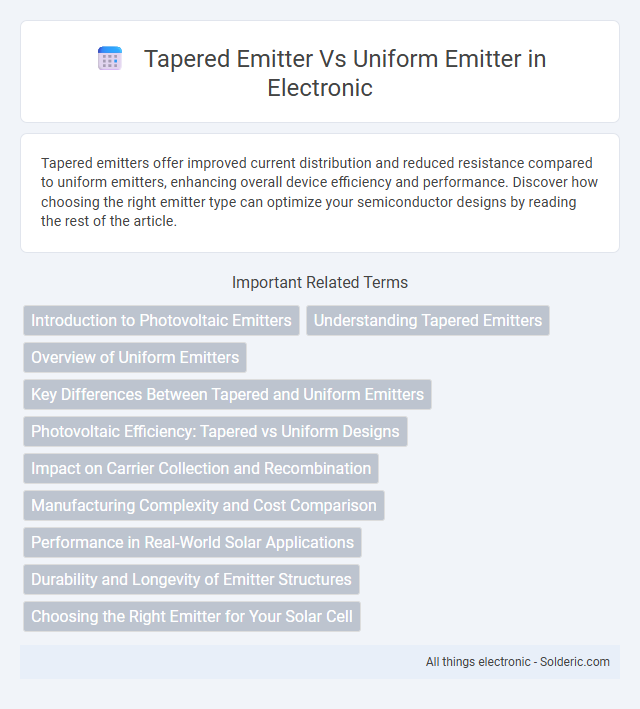Tapered emitters offer improved current distribution and reduced resistance compared to uniform emitters, enhancing overall device efficiency and performance. Discover how choosing the right emitter type can optimize your semiconductor designs by reading the rest of the article.
Comparison Table
| Feature | Tapered Emitter | Uniform Emitter |
|---|---|---|
| Design | Emitter width gradually decreases | Constant emitter width throughout |
| Current Distribution | Non-uniform, higher at narrow end | Uniform across the emitter length |
| Resistance | Lower series resistance due to tapering | Higher series resistance |
| Performance | Improved efficiency and gain | Standard efficiency and gain |
| Manufacturing Complexity | More complex fabrication process | Simpler to manufacture |
| Applications | High-performance BJTs and RF devices | General-purpose transistors |
Introduction to Photovoltaic Emitters
Tapered emitters in photovoltaic cells feature a gradual change in doping concentration, enhancing carrier collection efficiency and reducing recombination losses compared to uniform emitters, which maintain a consistent doping profile throughout. Uniform emitters provide simpler fabrication processes but often suffer from higher surface recombination velocities and lower overall cell efficiency. Optimizing emitter design, particularly favoring tapered structures, plays a crucial role in improving solar cell performance by balancing conductivity and minimizing recombination.
Understanding Tapered Emitters
Tapered emitters gradually change the emitter width along the device, enhancing current injection uniformity and improving overall device efficiency compared to uniform emitters with constant width. This design reduces carrier crowding and mitigates localized heating, leading to better performance and reliability in semiconductor applications. Understanding tapered emitters allows you to optimize device characteristics for higher output power and longer lifespan.
Overview of Uniform Emitters
Uniform emitters maintain a consistent cross-sectional area throughout their length, ensuring steady current flow and predictable electrical characteristics. They are widely used in semiconductor devices for simplified design and reliable performance under standard operating conditions. Your choice of a uniform emitter can provide stable gain and reduced fabrication complexity compared to tapered alternatives.
Key Differences Between Tapered and Uniform Emitters
Tapered emitters feature a gradually changing cross-section that improves current density distribution and reduces power loss, enhancing device efficiency and reliability. Uniform emitters maintain a constant cross-sectional area, leading to simpler fabrication but less optimized current flow and potential hot spots under high current conditions. Your choice between tapered and uniform emitters affects thermal management, device longevity, and overall performance in semiconductor applications.
Photovoltaic Efficiency: Tapered vs Uniform Designs
Tapered emitter designs in photovoltaic cells enhance efficiency by reducing surface recombination and improving charge carrier collection compared to uniform emitters. This structural variation optimizes current distribution and minimizes resistive losses, leading to higher power output. Your solar panels with tapered emitters can achieve better photovoltaic performance and greater energy yield under various lighting conditions.
Impact on Carrier Collection and Recombination
Tapered emitters enhance carrier collection efficiency by gradually reducing doping concentration, which minimizes surface recombination velocity and electric field-induced recombination. Uniform emitters, with constant doping profiles, often experience higher recombination rates due to abrupt junctions and increased surface defects, limiting carrier collection. Optimizing emitter tapering thus improves minority carrier lifetime and overall photovoltaic device performance.
Manufacturing Complexity and Cost Comparison
Tapered emitters involve more intricate lithography and precise doping processes, increasing manufacturing complexity compared to uniform emitters. This complexity results in higher production costs due to additional fabrication steps and tighter process controls. Uniform emitters benefit from simpler, more standardized manufacturing techniques, making them more cost-effective for large-scale semiconductor production.
Performance in Real-World Solar Applications
Tapered emitters in solar cells enhance current collection efficiency by reducing recombination losses at the front surface, resulting in higher overall power conversion efficiency compared to uniform emitters. Real-world applications benefit from tapered emitters due to improved short-circuit current density and fill factor under varying illumination and temperature conditions. Uniform emitters, while simpler to manufacture, generally exhibit lower performance metrics in field tests due to less effective charge carrier extraction and increased surface recombination.
Durability and Longevity of Emitter Structures
Tapered emitters enhance durability by minimizing stress concentration and improving mechanical stability compared to uniform emitters, which are prone to higher defect densities and localized wear. The gradual geometric transition in tapered emitters reduces thermal and electrical stress, resulting in longer operational lifespans under repeated use and harsh conditions. Uniform emitters often exhibit faster degradation due to uniform current density, which accelerates electromigration and material fatigue over time.
Choosing the Right Emitter for Your Solar Cell
Choosing the right emitter for your solar cell involves balancing efficiency and manufacturing complexity, where tapered emitters offer improved light trapping and reduced recombination by providing a gradient dopant profile. Uniform emitters, with consistent doping across the surface, simplify fabrication and provide reliable electrical contact but may suffer from higher surface recombination velocities. Optimizing emitter design based on cell architecture and application requirements directly impacts power conversion efficiency and overall device performance.
Tapered emitter vs Uniform emitter Infographic

 solderic.com
solderic.com